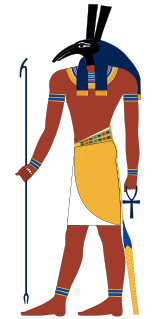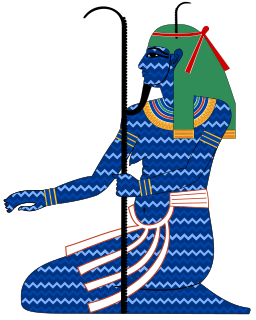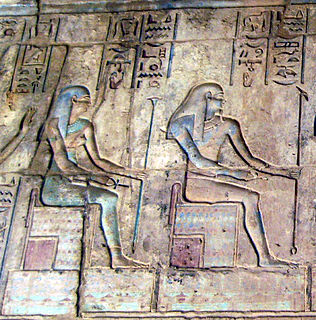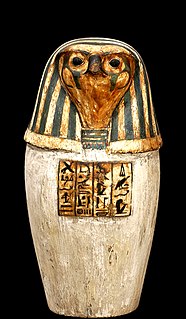| Perit | ||||||
|---|---|---|---|---|---|---|
| Name in hieroglyphs | ||||||
Perit is an underworld deity in Egyptian mythology. [2] She is one of the twelve goddesses in the ninth sector of Duat. [3]
| Perit | ||||||
|---|---|---|---|---|---|---|
| Name in hieroglyphs | ||||||
Perit is an underworld deity in Egyptian mythology. [2] She is one of the twelve goddesses in the ninth sector of Duat. [3]

Osiris is the god of fertility, agriculture, the afterlife, the dead, resurrection, life, and vegetation in ancient Egyptian religion. He was classically depicted as a green-skinned deity with a pharaoh's beard, partially mummy-wrapped at the legs, wearing a distinctive atef crown, and holding a symbolic crook and flail. He was one of the first to be associated with the mummy wrap. When his brother, Set, cut him up into pieces after killing him, Isis, his wife, found all the pieces and wrapped his body up, enabling him to return to life. Osiris was widely worshipped until the decline of ancient Egyptian religion during the rise of Christianity in the Roman Empire.

Horus or Heru, Hor, Har in Ancient Egyptian, is one of the most significant ancient Egyptian deities who served many functions, most notably as god of kingship and the sky. He was worshipped from at least the late prehistoric Egypt until the Ptolemaic Kingdom and Roman Egypt. Different forms of Horus are recorded in history, and these are treated as distinct gods by Egyptologists. These various forms may be different manifestations of the same multi-layered deity in which certain attributes or syncretic relationships are emphasized, not necessarily in opposition but complementary to one another, consistent with how the Ancient Egyptians viewed the multiple facets of reality. He was most often depicted as a falcon, most likely a lanner falcon or peregrine falcon, or as a man with a falcon head.

Set is a god of deserts, storms, disorder, violence, and foreigners in ancient Egyptian religion. In Ancient Greek, the god's name is given as Sēth (Σήθ). Set had a positive role where he accompanies Ra on his barque to repel Apep, the serpent of Chaos. Set had a vital role as a reconciled combatant. He was lord of the Red Land, where he was the balance to Horus' role as lord of the Black Land.

Thoth is an ancient Egyptian deity. In art, he was often depicted as a man with the head of an ibis or a baboon, animals sacred to him. His feminine counterpart was Seshat, and his wife was Ma'at. He was the god of the moon, wisdom, writing, hieroglyphs, science, magic, art, and judgment. His Greek equivalent is Hermes.

Nut, also known by various other transcriptions, is the goddess of the sky, stars, cosmos, mothers, astronomy, and the universe in the ancient Egyptian religion. She was seen as a star-covered nude woman arching over the Earth, or as a cow. She was depicted wearing the water-pot sign (nw) that identifies her.

Nu or Nun, is the personification of the primordial watery abyss which existed at the time of creation and from which the creator sun god Ra arose, in ancient Egyptian religion. Nu is one of the eight deities of the Ogdoad representing ancient Egyptian primordial Chaos from which the primordial mound arose from. Nun can be seen as the first of all the gods and the creator of reality and personification of the cosmos. Nun is also considered the god that will destroy existence and return everything to the Nun from whence it came. No cult was addressed to Nun.

Amunet or Imnt ; also spelled Amonet or Amaunet; Koinē Greek: Αμαυνι) is a primordial goddess in ancient Egyptian religion. Thebes was the center of her worship through the last dynasty, the Ptolemaic Kingdom, in 30 BC. She is attested in the earliest known of Egyptian religious texts and, as was the custom, was paired with a counterpart who is entitled with the same name, but in the masculine, Amun. They were thought to have existed prior to the beginning of creation along with three other couples representing primeval concepts.

Kek is the deification of the concept of primordial darkness in the ancient Egyptian Ogdoad cosmogony of Hermopolis.

Maat or Maʽat refers to the ancient Egyptian concepts of truth, balance, order, harmony, law, morality, and justice. Ma'at was also the goddess who personified these concepts, and regulated the stars, seasons, and the actions of mortals and the deities who had brought order from chaos at the moment of creation. Her ideological opposite was Isfet, meaning injustice, chaos, violence or to do evil.

Neith was an early ancient Egyptian deity. She was said to be the first and the prime creator, who created the universe and all it contains, and that she governs how it functions. She was the goddess of the cosmos, fate, wisdom, water, rivers, mothers, childbirth, hunting, weaving, and war.

Babi, also Baba, in ancient Egyptian religion, was the deification of the hamadryas baboon, one of the animals present in ancient Egypt. His name is usually translated as "bull of the baboons", roughly meaning "chief of the baboons".

Meretseger was a Theban cobra-goddess in ancient Egyptian religion, in charge with guarding and protecting the vast Theban Necropolis — on the west bank of the Nile, in front of Thebes — and especially the heavily guarded Valley of the Kings. Her cult was typical of the New Kingdom of Egypt.
Rem, also Rem-Rem, Remi, or Remi the Weeper, who lives in Rem-Rem, the realm of weeping, was a fish god in Egypt who fertilized the land with his tears, producing both vegetation and the reptiles. He is assumed to be the personification of Ra's tears.

The Book of Gates is an ancient Egyptian funerary text dating from the New Kingdom. It narrates the passage of a newly deceased soul into the next world, corresponding to the journey of the sun through the underworld during the hours of the night. The soul is required to pass through a series of 'gates' at different stages in the journey. Each gate is associated with a different goddess, and requires that the deceased recognise the particular character of that deity. The text implies that some people will pass through unharmed, but that others will suffer torment in a lake of fire.

Sir Ernest Alfred Thompson Wallis Budge was an English Egyptologist, Orientalist, and philologist who worked for the British Museum and published numerous works on the ancient Near East. He made numerous trips to Egypt and the Sudan on behalf of the British Museum to buy antiquities, and helped it build its collection of cuneiform tablets, manuscripts, and papyri. He published many books on Egyptology, helping to bring the findings to larger audiences. In 1920, he was knighted for his service to Egyptology and the British Museum.

Qebehsenuef is an ancient Egyptian deity. He is one of the four sons of Horus in Egyptian mythology, the god of protection and of the West. In the preparation of mummies, his canopic jar was used for the intestines. He is seen as a mummy with a falcon head. He was said to be protected by the goddess Serket. The intestine was used in sacrificed animals, by soothsayers, to predict the future, whereas the intestines were also the victims of poison. With death by poison, the canopic jar deity is protected by Serket, who bears the emblem of the scorpion:
[Qebhsennuf saith:] "I am thy son, O Osiris Ani, triumphant. I have come to protect thee. I have collected thy bones, and I have gathered together thy members. I have brought thy heart and I have placed it upon its throne within thy body. I have made thy house to flourish after thee, O thou who livest for ever.

Raet (Rˁỉ.t) or Raet-Tawy (Rˁỉ.t-tȝ.wỉ) is an ancient Egyptian solar deity, the female aspect of Ra. Her name is simply the female form of Ra's name; the longer name Raet-Tawy means "Raet of the Two Lands".

The Assessors of Maat were 42 minor ancient Egyptian deities of the Maat charged with judging the souls of the dead in the afterlife by joining the judgment of Osiris in the Weighing of the Heart.
Amu-Aa or, is one of the gods that goes with Osiris during the second hour of the night.